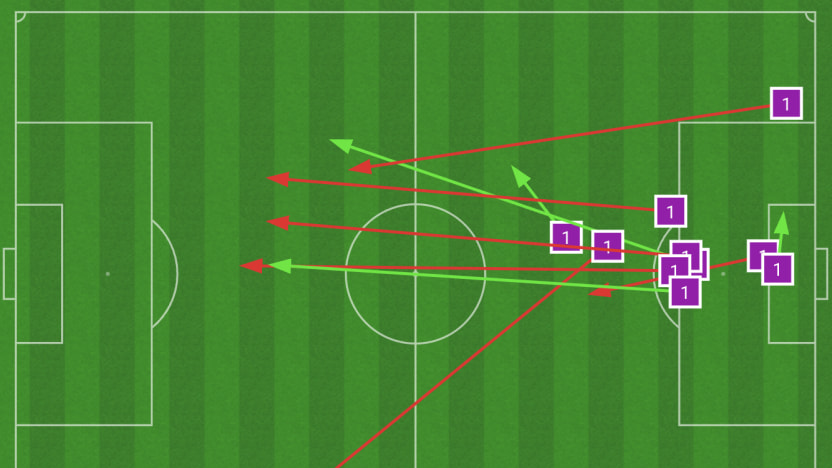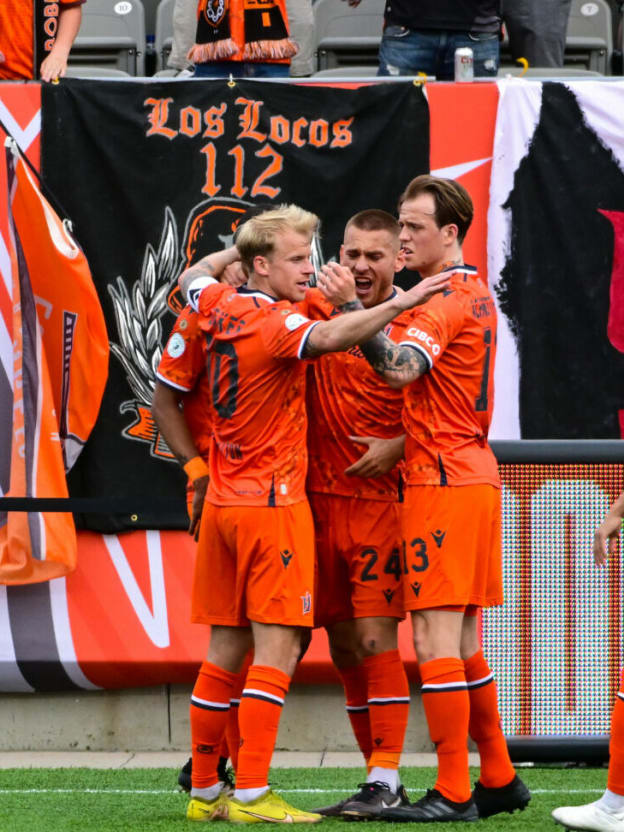As Forge FC head into Wednesday’s Canadian Championship semifinal against CF Montréal, they find themselves once again at the top of the Canadian Premier League table. The Hamilton club, which has won three of the four CPL championships in the league’s history including the most recent in October 2022, has been a juggernaut under head coach Bobby Smyrniotis. This year, they’ve started the league campaign with three wins and three draws, which have put them in a good early position to continue that success. Forge have always been perhaps the most well-drilled tactical unit in the CPL, particularly with how committed they’ve been historically to playing expansive, possession-based football against any opponent — be they a CPL foe, a high-level enemy in Concacaf action or an MLS side in the Voyageurs’ Cup. This season, though, we’ve seen them evolve once again. With the basic tactical fundamentals so ingrained in the core players that have been at this club for so long, they’ve been more effective than ever at adapting to specific game situations and opponents. Smyrniotis and co. will undoubtedly be working hard this week on a game plan uniquely tailored for CF Montréal, but here are a few specific things that have worked for Forge so far this year.
Attacking in behind
One of the most impressive aspects of Forge’s game-by-game approach has been their tendency to identify specific ways they can break down an opponent. In a couple of recent wins — over York United and Valour FC — Forge opted to attack via wide areas, but in slightly different ways. Against York, they played in a 4-1-4-1 that had usual centre-forward Woobens Pacius on the left wing and Tristan Borges in a sort of drifting number 10 role in the right half-space. The result was a marvellous performance for Borges in both chance creation and ball-winning as the main force breaking up York’s transition, as well as an assist for Pacius stemming directly from a long ball to him out wide. Against Valour, though, Borges moved back out to the right wing. Forge had noticed in their preparations that Valour left-back Matteo De Brienne has a tendency to be aggressive and step forward as a more attack-minded player than a traditional defensive fullback. So, Forge made it their number one priority for the game to get runners in behind De Brienne and play the ball into the pocket of space behind his shoulder. The video below compiles a few examples from throughout the game of how Forge deliberately moved the ball to the right and found a way to get a pass into a man in behind the fullback followed by a cross or run toward goal. Borges and Rezart Rama in particular worked in tandem to get De Brienne to commit to a ball-carrier or pass while the other slipped behind. >
function vastFromTags(tags, channels) {
if (tags) { var keywords = '&Tags=' + tags; } channels = channels.replace(/-/g, " ") channels = channels.replace(/_/g, " ") var ad_timecode = Date.now(); var ad_sitecode = ''; keywords += '&lang=eng'; if (channels) keywords += '&Channel=' + channels; var ad_vasttag = 'https://pubads.g.doubleclick.net/gampad/ads?sz=640x480&iu=' + ad_sitecode + '&impl=s&gdfp_req=1&vpos=preroll&env=vp&output=xml_vast2&unviewed_position_start=1&ciu_szs=728x90,300x250' + '&cust_params=' + encodeURIComponent(keywords) + '&url=' + encodeURIComponent(window.location) + '&correlator=' + ad_timecode; try { console.log("VAST: " + ad_vasttag); } catch (error) { // ie } return ad_vasttag;}
jQuery(document).ready(function() { jwplayer("video_e2d718462e95").setup({ width: "100%", height: "100%", loadAtInit: true, autostart: false, mute: true, aspectratio: "16:9", primary: "html5", stretching: "uniform", advertising: { client: "vast", tag: vastFromTags('', ''), }, image: "https://cdn.canpl.ca/app/uploads/cpl/2023/05/21085423/forge_in_behind_clips_1_01.jpg", sources: [{"label":"mp4_360p","file":"https://cdn.canpl.ca/videos/2023/05/21/forge_in_behind_clips_1_mp4_360p.mp4","width":"360"},{"label":"mp4_720p","file":"https://cdn.canpl.ca/videos/2023/05/21/forge_in_behind_clips_1_mp4_720p.mp4","width":"720","default":"true"}], related: { file: "/app/themes/base/templates/video-related.php?id=&video_channel=0", onclick: "link", oncomplete: "show", autoplaytimer: 10 }, ga: {} }); })
Forge created most of their chances in that game by doing this, including all three goals. In this last example below, see how Forge at first are unable to get anybody behind Valour’s backline, so they continue to probe — until, at last, Kyle Bekker spots a lane and runs diagonally outward into the space (kept onside by a defender in the box), and he’s in perfect position to receive and send in the cross for Kwasi Poku’s goal: >
function vastFromTags(tags, channels) {
if (tags) { var keywords = '&Tags=' + tags; } channels = channels.replace(/-/g, " ") channels = channels.replace(/_/g, " ") var ad_timecode = Date.now(); var ad_sitecode = ''; keywords += '&lang=eng'; if (channels) keywords += '&Channel=' + channels; var ad_vasttag = 'https://pubads.g.doubleclick.net/gampad/ads?sz=640x480&iu=' + ad_sitecode + '&impl=s&gdfp_req=1&vpos=preroll&env=vp&output=xml_vast2&unviewed_position_start=1&ciu_szs=728x90,300x250' + '&cust_params=' + encodeURIComponent(keywords) + '&url=' + encodeURIComponent(window.location) + '&correlator=' + ad_timecode; try { console.log("VAST: " + ad_vasttag); } catch (error) { // ie } return ad_vasttag;}
jQuery(document).ready(function() { jwplayer("video_4c229dd45b58").setup({ width: "100%", height: "100%", loadAtInit: true, autostart: false, mute: true, aspectratio: "16:9", primary: "html5", stretching: "uniform", advertising: { client: "vast", tag: vastFromTags('', ''), }, image: "https://cdn.canpl.ca/app/uploads/cpl/2023/05/21085602/forge_in_behind_clips_2_01.jpg", sources: [{"label":"mp4_360p","file":"https://cdn.canpl.ca/videos/2023/05/21/forge_in_behind_clips_2_mp4_360p.mp4","width":"360"},{"label":"mp4_720p","file":"https://cdn.canpl.ca/videos/2023/05/21/forge_in_behind_clips_2_mp4_720p.mp4","width":"720","default":"true"}], related: { file: "/app/themes/base/templates/video-related.php?id=&video_channel=0", onclick: "link", oncomplete: "show", autoplaytimer: 10 }, ga: {} }); })
Pressure to win the ball
Forge have won possession in the attacking third more than any other team in the CPL this year. In matches where they expect to have the ball, they’re patient in moving it forward, but if they lose possession they’ll be aggressive in counter-pressing to retrieve the ball. In their 1-1 draw with Halifax Wanderers, Forge were at their most aggressive with their press; the next video demonstrates how players will step forward high in the attacking third to either win the ball back themselves or force a Wanderers defender to play it long for an eventual turnover. With Halifax making a concerted effort to play out of the back this match, Forge were able to win the ball 15 times high up the pitch to spring quick attacks. >
function vastFromTags(tags, channels) {
if (tags) { var keywords = '&Tags=' + tags; } channels = channels.replace(/-/g, " ") channels = channels.replace(/_/g, " ") var ad_timecode = Date.now(); var ad_sitecode = ''; keywords += '&lang=eng'; if (channels) keywords += '&Channel=' + channels; var ad_vasttag = 'https://pubads.g.doubleclick.net/gampad/ads?sz=640x480&iu=' + ad_sitecode + '&impl=s&gdfp_req=1&vpos=preroll&env=vp&output=xml_vast2&unviewed_position_start=1&ciu_szs=728x90,300x250' + '&cust_params=' + encodeURIComponent(keywords) + '&url=' + encodeURIComponent(window.location) + '&correlator=' + ad_timecode; try { console.log("VAST: " + ad_vasttag); } catch (error) { // ie } return ad_vasttag;}
jQuery(document).ready(function() { jwplayer("video_5b586a9cc865").setup({ width: "100%", height: "100%", loadAtInit: true, autostart: false, mute: true, aspectratio: "16:9", primary: "html5", stretching: "uniform", advertising: { client: "vast", tag: vastFromTags('', ''), }, image: "https://cdn.canpl.ca/app/uploads/cpl/2023/05/21085857/forge_high_press_clips_2_01.jpg", sources: [{"label":"mp4_360p","file":"https://cdn.canpl.ca/videos/2023/05/21/forge_high_press_clips_2_mp4_360p.mp4","width":"360"},{"label":"mp4_720p","file":"https://cdn.canpl.ca/videos/2023/05/21/forge_high_press_clips_2_mp4_720p.mp4","width":"720","default":"true"}], related: { file: "/app/themes/base/templates/video-related.php?id=&video_channel=0", onclick: "link", oncomplete: "show", autoplaytimer: 10 }, ga: {} }); })
Dictating tempo
Something Bobby Smyrniotis prides his teams on is their ability to be the protagonists of a match, deciding how and when the game opens up or slows down. Forge’s away win at Pacific FC had some examples of this. Early in the match, Forge spent more time on the ball and probed the defence, and it didn’t take long before Pacius scored to make it 1-0. They didn’t shift gear immediately, but shortly after halftime it seemed the order came down to give up some possession to preserve the defensive shape. More on how that defensive shape worked in a moment, but first, one stat for goalkeeper Triston Henry paints a picture of Forge’s shift in tactics in the second half. Forge typically play out of the back with short passes — Henry has the highest pass accuracy of any goalkeeper in the league, which indicates a tendency to play short to his centre-backs. In the second half, though, Henry was much more likely to send it long on goal kicks, which often gave the ball back to Pacific but deeper on the pitch, avoiding any attempts to press high.

Defending as a unit
On the smaller pitch at Starlight Stadium, Forge did very well to maintain a compact defensive shape while also forcing the opponent to the sides — it’s easier to step up and press an attacker to make him move the ball and then retreat into position when there’s less ground to cover. Once Forge opted to see out the game with a lead in the second half, they committed fully to shifting in unison to take away central passing lanes and mark Pacific’s attackers trying to get between the lines. See below how many times Pacific were forced into low-percentage shots from distance or crosses from the touchline, with nobody able to get open in the box for those crosses due to responsible marking. This was perhaps Manjrekar James’s best game yet for Forge; his experience helped him organize the backline and pick his own moments to jump into a passing lane to win the ball. >
function vastFromTags(tags, channels) {
if (tags) { var keywords = '&Tags=' + tags; } channels = channels.replace(/-/g, " ") channels = channels.replace(/_/g, " ") var ad_timecode = Date.now(); var ad_sitecode = ''; keywords += '&lang=eng'; if (channels) keywords += '&Channel=' + channels; var ad_vasttag = 'https://pubads.g.doubleclick.net/gampad/ads?sz=640x480&iu=' + ad_sitecode + '&impl=s&gdfp_req=1&vpos=preroll&env=vp&output=xml_vast2&unviewed_position_start=1&ciu_szs=728x90,300x250' + '&cust_params=' + encodeURIComponent(keywords) + '&url=' + encodeURIComponent(window.location) + '&correlator=' + ad_timecode; try { console.log("VAST: " + ad_vasttag); } catch (error) { // ie } return ad_vasttag;}
jQuery(document).ready(function() { jwplayer("video_e6a74fe3aacc").setup({ width: "100%", height: "100%", loadAtInit: true, autostart: false, mute: true, aspectratio: "16:9", primary: "html5", stretching: "uniform", advertising: { client: "vast", tag: vastFromTags('', ''), }, image: "https://cdn.canpl.ca/app/uploads/cpl/2023/05/21091257/forge_defending_01.jpg", sources: [{"label":"mp4_360p","file":"https://cdn.canpl.ca/videos/2023/05/21/forge_defending_mp4_360p.mp4","width":"360"},{"label":"mp4_720p","file":"https://cdn.canpl.ca/videos/2023/05/21/forge_defending_mp4_720p.mp4","width":"720","default":"true"}], related: { file: "/app/themes/base/templates/video-related.php?id=&video_channel=0", onclick: "link", oncomplete: "show", autoplaytimer: 10 }, ga: {} }); })
Overall, there are plenty of reasons why Forge continue to be a top team in the Canadian Premier League — depth and individual player quality being chief among them. Still, the way they continue to progress under Bobby Smyrniotis to be the league’s most tactically flexible and coherent side is what gives them such an edge at the moment. Although CF Montréal enter this week’s semifinal in good form, they’ll have to be wary of the preparation Forge will undoubtedly have done in their attempt to at last defeat an MLS opponent.
All clips courtesy of OneSoccer
